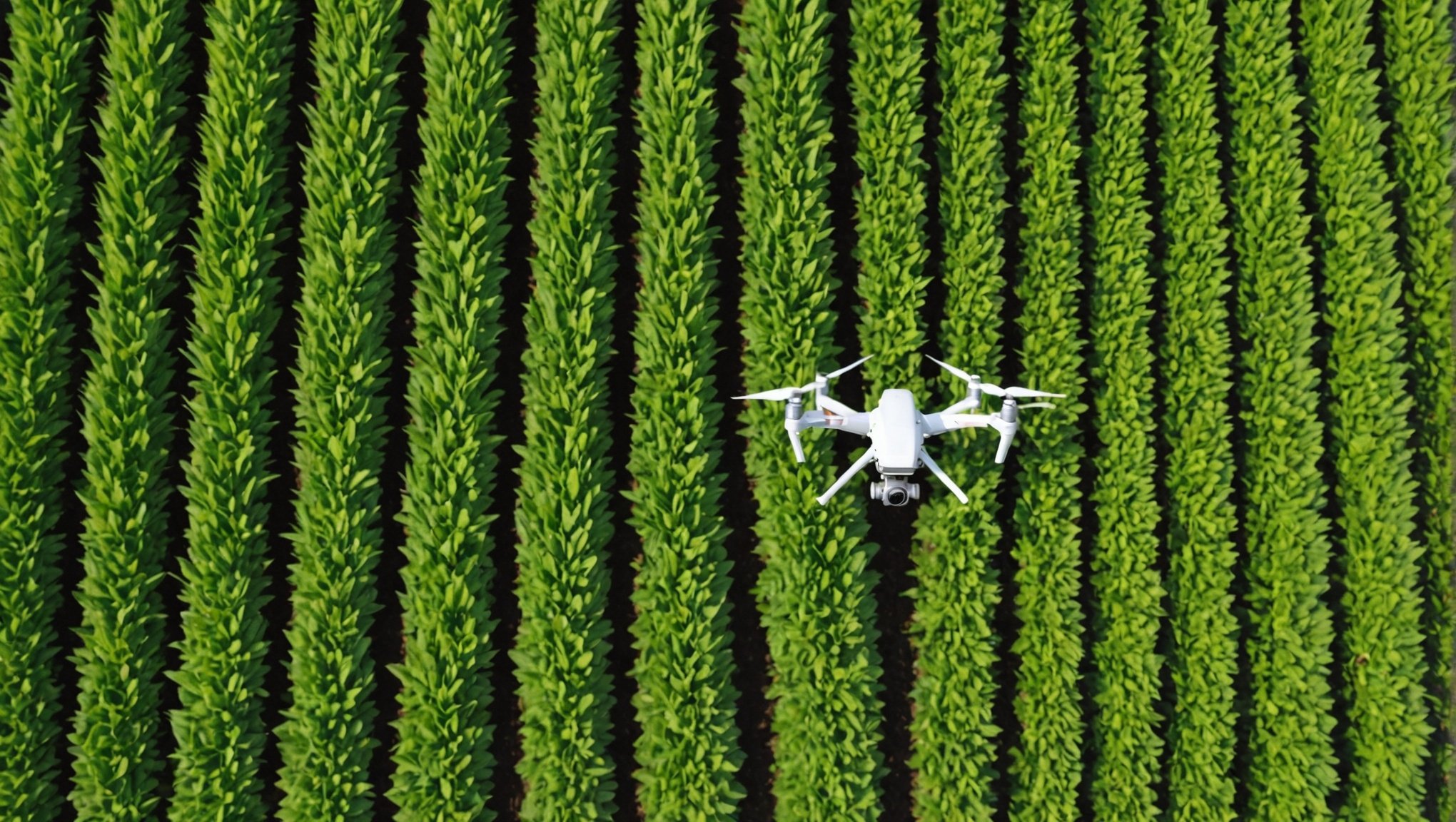Revolutionizing Crop Care: How Drone Monitoring in Precision Agriculture Can Lower Pesticide Usage
In the ever-evolving landscape of agriculture, the integration of drone technology is transforming the way farmers manage their crops, particularly in the realm of precision agriculture. One of the most significant benefits of this technological advancement is the potential to lower pesticide usage, a crucial step towards more sustainable and environmentally friendly farming practices. Let’s delve into how drone monitoring is revolutionizing crop care and reducing the need for pesticides.
The Rise of Precision Agriculture
Precision agriculture, also known as precision farming, involves using advanced technology to optimize crop yields and reduce waste. This approach is driven by the collection and analysis of detailed data about crops, soil conditions, and environmental factors. At the heart of this revolution are agricultural drones, which are equipped with sophisticated sensors and cameras that provide real-time data on crop health, soil moisture, and other critical parameters.
Also to discover : Revolutionizing Urban Navigation: How AI-Enhanced Smart Glasses Can Empower the Visually Impaired
Key Technologies in Precision Agriculture:
| Technology | Key Features | Benefits | Estimated Yield Improvement |
|---|---|---|---|
| Satellite Imagery | High-resolution multispectral imaging | Large-scale crop monitoring, early stress detection | 5-10% |
| Soil Sensors | Real-time soil data collection | Optimized irrigation and fertilization | 7-15% |
| Weather Stations | Localized weather forecasting | Improved planning, reduced weather-related losses | 3-8% |
| Drone Mapping | High-resolution aerial imagery and data collection | Precise crop scouting, targeted treatments | 8-20% |
These technologies, especially drone mapping, are pivotal in precision agriculture, enabling farmers to make informed decisions and optimize resource use[1].
In the same genre : Unlock the secrets of the ultimate zombies mystery box!
Drone Technology in Crop Monitoring
Drones equipped with multispectral cameras, advanced radars, and other sensors are revolutionizing crop monitoring. Here are some key ways drones are making a difference:
Early Detection of Pest Infestations and Diseases
Drones can capture detailed aerial images that reveal early signs of pest infestations and diseases. This early detection allows farmers to take prompt action, reducing the need for widespread pesticide application. For instance, UAV-based hyperspectral imaging can assess canopy height, coverage, and physiological activity, such as chlorophyll production, providing a comprehensive view of crop health[2].
Targeted Irrigation and Fertilization
Multispectral imaging can detect variations in crop temperature, which is often indicative of water stress. This information enables farmers to implement targeted irrigation strategies, applying water only where and when it’s needed. Similarly, drones can create detailed nutrient maps, identifying areas that require more or less fertilizer, thus minimizing overapplication and reducing environmental pollution[3].
Precision Spraying
Drones can be used for precise pesticide application, significantly reducing the amount of chemicals used. Traditional methods often result in overapplication, which not only wastes resources but also harms the environment. With drones, farmers can apply treatments with pinpoint accuracy, minimizing the impact on beneficial insects and the surrounding environment[3].
Reducing Pesticide Usage Through Precision
The use of drones in precision agriculture is directly contributing to a reduction in pesticide usage in several ways:
- Targeted Treatments: By identifying specific areas of the crop that are affected by pests or diseases, drones enable farmers to apply pesticides only where necessary, rather than treating the entire field.
- Early Intervention: Early detection of issues allows for timely interventions, often using more environmentally friendly methods such as introducing beneficial insects or using organic pesticides.
- Data-Driven Decisions: Real-time data from drones helps farmers make informed decisions about when and how to apply pesticides, reducing the likelihood of overapplication.
Benefits of Reduced Pesticide Usage:
- Environmental Impact: Lower pesticide usage minimizes the environmental impact, reducing the risk of chemical runoff into water systems and protecting beneficial insects.
- Cost Savings: Targeted treatments reduce the amount of pesticides used, leading to cost savings for farmers.
- Improved Crop Health: By addressing issues early and using targeted treatments, farmers can improve overall crop health and quality.
Case Study: UAV-Based Hyperspectral Imaging
A study in China highlighted the effectiveness of UAV-based hyperspectral imaging in monitoring maize re-growth after lodging. This technique allowed for rapid, non-destructive evaluation of plant health and growth, enabling farmers to make precise interventions. The researchers noted that this method is more efficient and accurate than traditional methods, which require significant time and human resources[2].
The Role of AI in Precision Agriculture
Artificial Intelligence (AI) is further enhancing the capabilities of agricultural drones. By combining AI with drone technology, farmers can access predictive analytics, automated crop health assessments, and personalized recommendations for optimal yield.
Key Applications of AI and Drones:
- Predictive Analytics: AI can analyze historical and real-time data to predict crop yields, detect potential issues before they arise, and recommend optimal management strategies.
- Automated Crop Health Assessments: AI-powered drones can automatically assess crop health, identifying areas of stress or disease without human intervention.
- Personalized Recommendations: Based on the data collected, AI can provide farmers with tailored advice on irrigation, fertilization, and pest management.
Practical Insights and Actionable Advice
For farmers looking to integrate drone technology into their farming practices, here are some practical insights and actionable advice:
Invest in the Right Equipment
- Choose Drones with Multispectral Cameras: These cameras provide detailed insights into crop health and soil conditions.
- Consider Weather Stations: Localized weather data can help in planning and protecting crops from adverse conditions.
Use Data to Make Informed Decisions
- Analyze Real-Time Data: Use the data collected from drones to make informed decisions about irrigation, fertilization, and pest management.
- Integrate with Existing Systems: Platforms like Farmonaut’s API allow seamless integration of drone and satellite data into existing farm management systems[5].
Adopt Sustainable Practices
- Targeted Treatments: Use drones for precise pesticide application to minimize chemical usage.
- Early Intervention: Address issues early to avoid the need for heavy pesticide use.: Embracing the Future of Agriculture
The integration of drone technology in precision agriculture is not just a trend; it’s a transformative force that is revolutionizing the way we manage crops. By providing real-time data, enabling targeted treatments, and reducing pesticide usage, drones are helping farmers achieve higher yields while minimizing environmental impact.
As the agricultural sector continues to evolve, embracing these innovations will be crucial for farmers, agri-businesses, and technology providers. The future of farming is here, and it’s powered by intelligence – both artificial and human.
In the words of Liping Chen, a professor with the Research Center of Information Technology, Beijing Academy of Agriculture and Forestry, “By making this advanced tool a standard component in crop monitoring, we aim to significantly enhance the accuracy and efficiency of assessing plant health and recovery. This will enable farmers and agronomists to manage crops more effectively, optimize interventions, and ultimately increase yield and productivity.”[2]
As we move forward, the synergy between AI, drone technology, and traditional farming practices will undoubtedly yield a more efficient, sustainable, and productive agricultural sector. The revolution in crop care is underway, and it’s time to join the journey.











